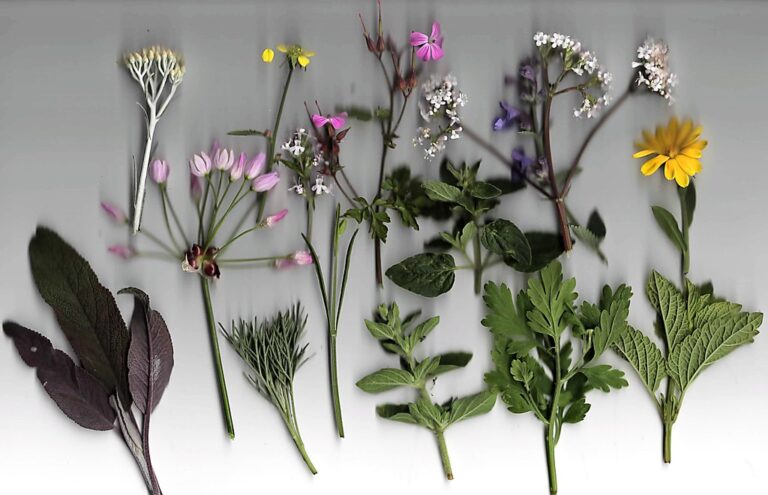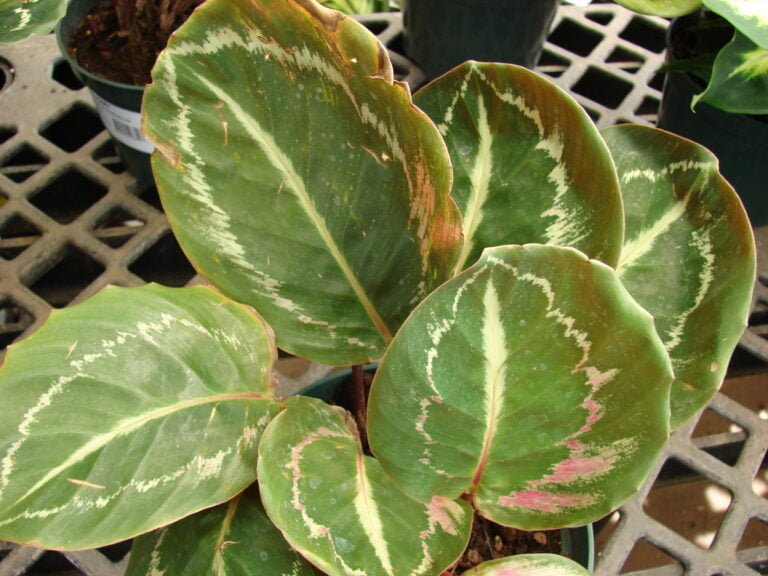Understanding Ideal Soil Conditions and Organic Fertilization for Herbs
Understanding ideal soil conditions and organic fertilization for herbs is key for their health. Herbs like basil, mint, rosemary, and thyme have specific nitrogen and pH preferences for best growth. Aim for soil rich in organic matter (5-10%) with a pH of 6.0-7.5. Microbes help with nutrient cycling and soil health. Organic fertilizers such as fish emulsion and compost tea boost soil health, unlike synthetic options. Different herbs need varying nitrogen levels; basil and mint prefer high-nitrogen, while rosemary and thyme thrive with low-nitrogen. Balancing water retention and drainage is essential. Maintaining proper soil health is vital for vibrant herb growth.
Herb Nutritional Requirements and Ph Levels
In cultivating herbs successfully, understanding their specific nutritional requirements and ideal pH levels is essential for promoting robust growth and longevity. Different herbs like basil, mint, rosemary, and thyme have varying needs in terms of soil composition and nutrient levels. For example, basil thrives best when the soil’s nitrogen levels are maintained between 150-200 mg/L, and the pH falls within the range of 6.0-7.5. Mint, similar to basil, requires sufficient nitrogen levels and a slightly acidic to neutral pH for growth. On the other hand, rosemary prefers well-draining soil, nitrogen levels ranging from 50-100 mg/L, and a pH level between 6.0-7.5. Thyme, recognized for its resilience, does well in lean and dry soil conditions with nitrogen levels similar to rosemary and a slightly broader ideal pH range of 6.0-8.0.
Maintaining the right balance of nutrients in the soil is crucial for herb growth. Nitrogen, in particular, plays a vital role in facilitating healthy leaf and stem development. Additionally, ensuring the soil’s pH is within the appropriate range helps in making necessary nutrients available to the herbs. Organic matter in the soil aids in nutrient retention and microbial activity, further supporting the overall health of the herbs. By understanding the specific nutritional requirements and pH preferences of different herbs, one can create an environment that fosters their growth and productivity.
Importance of Soil Health for Herbs
Maintaining ideal soil health is essential for cultivating healthy and flourishing herb plants. To guarantee the best conditions for herb growth, several key factors must be considered:
- Organic Matter Content: Herb plants require a soil rich in organic matter, ideally between 5-10%. Organic matter boosts soil structure, water retention, and nutrient availability, promoting robust herb growth.
- Ideal pH Range: The pH level of the soil is critical for herb plants, with an optimal range falling between 6.0-7.5. This range supports the availability of essential nutrients for herbs to thrive.
- Microbial Activity: Microbes play a crucial role in soil health by aiding in nutrient cycling. Beneficial soil microbes break down organic matter, releasing nutrients that are then accessible to herb plants for uptake.
- NPK Requirements: Different herbs have specific nitrogen, phosphorus, and potassium requirements for healthy growth. Understanding and providing these nutrients in the right amounts are vital for the overall health and productivity of herb plants.
Balanced water retention and proper drainage are also fundamental aspects of soil health for herb cultivation. Adequate water availability without waterlogging ensures that herb plants can access the necessary nutrients for optimal growth. By focusing on these factors, we can create an environment that supports the growth and vitality of herb plants through sustainable practices like organic fertilization.
Organic Vs. Synthetic Fertilizers for Herbs
When deciding between organic and synthetic fertilizers for herb cultivation, it is essential to consider the long-term soil health benefits provided by organic options. Organic fertilizers such as fish emulsion, compost tea, and seaweed extract offer significant advantages for herb plants compared to synthetic alternatives. These organic options contribute to the overall sustainability of herb gardens by improving soil structure, promoting beneficial microbial activity, and boosting nutrient uptake for long-term plant health.
Fish emulsion and compost tea are rich in organic matter, providing a gradual release of nutrients that benefit herb plants over time. These nutrients not only support immediate growth but also help establish soil fertility for future seasons. Seaweed extract, on the other hand, plays an important role in stimulating root development in herbs, leading to stronger and healthier plants that are more resistant to environmental stressors.
In contrast, synthetic fertilizers lack the soil-improving properties of organic alternatives, often resulting in nutrient imbalances and reduced microbial diversity in the soil. While synthetic options may offer a quick nutrient boost, they do not support the long-term health of herb plants or the soil ecosystem.
Ultimately, the choice between organic and synthetic fertilizers for herbs should prioritize the sustainable management of soil health and the overall well-being of the plants. By incorporating organic fertilizers like fish emulsion, compost tea, and seaweed extract, herb gardeners can cultivate thriving plants with improved nutrient uptake and enhanced long-term vitality.
Fertilization Strategies for Different Herbs
Tailoring fertilization to suit the specific nutrient requirements of different herbs is essential for optimizing their growth and overall health. Each herb has unique preferences when it comes to fertilizers, and understanding these specific needs is vital for cultivating healthy and thriving plants. Here are some key strategies for fertilizing different herbs:
- Basil and Mint: These herbs thrive when provided with high-nitrogen fertilizers. Nitrogen supports lush leafy growth, which is characteristic of these herbs. Regular applications of nitrogen-rich fertilizers can help guarantee robust and productive basil and mint plants.
- Rosemary and Thyme: Rosemary and thyme prefer low-nitrogen conditions and well-draining soil. Excessive nitrogen can lead to overly lush growth, which may compromise the flavor and aroma of these herbs. Opt for fertilizers with lower nitrogen content to promote the best growth conditions for rosemary and thyme.
- Cilantro and Parsley: Balanced fertilizers are ideal for cilantro and parsley. These herbs benefit from a mix of nutrients to support continuous harvesting. Providing organic options rich in essential nutrients can help maintain the health and productivity of cilantro and parsley plants.
- Specific Needs: Different herbs have specific fertilizer needs based on their growth characteristics. Conducting a soil test can help determine the nutrient levels in the soil, allowing for targeted fertilization to address any deficiencies and promote the most favorable growth.
Best Practices for Herb Fertilization
I’ll cover the benefits of organic fertilizers, the importance of timing for fertilization, and how soil nutrient absorption plays a vital role in herb growth.
Organic Fertilizer Benefits
Utilizing natural fertilizers in herb cultivation improves soil fertility and nurtures sustainable growth, fostering a thriving herb garden ecosystem.
- Improved Soil Health: Natural fertilizers enrich the soil with essential nutrients, promoting long-term soil fertility.
- Promotes Biodiversity: By reducing environmental impact and enhancing microbial activity, natural fertilization supports a diverse range of plant species in the herb garden.
- Gradual-Release Nutrients: Gradual-release natural fertilizers provide a steady supply of nutrients, matching the natural growth pace of herbs and benefiting slow-growing varieties.
- Environmentally-Friendly Practices: Using natural fertilizers reduces chemical runoff, supports the ecosystem, and lowers the carbon footprint compared to synthetic alternatives.
Natural fertilization not only benefits the immediate herb garden but also contributes to a healthier environment and sustainable gardening practices.
Timing for Fertilization
For ideal herb growth and development, timing plays a pivotal role in determining the effectiveness of fertilization practices. Fertilize herbs in early spring as they break dormancy to support peak growth. It is essential to adjust the timing of fertilization based on specific herb requirements and growth phases. Avoid late-season fertilization to prevent new growth from being damaged by frost. To guarantee herb health and peak growth, monitor their growth closely. Consider using slow-release organic fertilizers to provide a steady nutrient supply throughout the growing season. By following these practices and being mindful of the timing of fertilization, you can help your herbs thrive and avoid issues such as frost damage.
Soil Nutrient Absorption
As herbs grow, their ability to absorb nutrients from the soil is influenced by various factors, including soil composition and nutrient availability. To guarantee ideal soil nutrient absorption for herb plants, consider the following key points:
- Well-Draining Soil: Herbs flourish in well-draining soil with a pH range of 6.0-7.5, promoting effective nutrient uptake.
- Organic Matter Content: Maintain 5-10% organic matter in the soil to support microbial activity essential for nutrient cycling and herb health.
- Nitrogen Requirements: Different herbs have varying nitrogen needs, like basil requiring 150-200 mg/L and rosemary needing 50-100 mg/L.
- Water Retention and Drainage: Balanced water retention and proper drainage are essential for herb plants to thrive and efficiently absorb nutrients.
Understanding these aspects of soil health is crucial for fostering robust herb growth.
Watering Techniques for Fertilization Success
Ensuring successful fertilization for herbs requires understanding proper moisture levels and the frequency of watering is essential. Maintaining consistent soil moisture supports effective nutrient uptake, while overwatering can lead to nutrient leaching and impact herb health. To encourage robust root development and efficient fertilization, it is recommended to water herbs deeply but infrequently.
Proper Moisture Levels
Maintaining proper moisture levels in the soil is a critical factor for successful organic fertilization of herbs. Here are key points to take into account for effective watering techniques that support herb growth and fertilization:
- Avoid Overwatering: Prevent root rot and nutrient leaching by ensuring adequate drainage and allowing the soil to partially dry out between waterings.
- Monitor Soil Moisture: Regularly check soil moisture levels through observation and the finger-test to adjust watering frequency accordingly.
- Promote Root Development: Encourage strong root systems with deep, infrequent watering to improve nutrient absorption and support healthy herbs.
- Ensure Nutrient Uptake: Maintain ideal soil moisture levels to facilitate efficient distribution of nutrients for the overall well-being of herb plants.
Frequency of Watering
To guarantee optimal herb growth and successful organic fertilization, understanding the specific watering needs of different herbs is essential. Some herbs prefer frequent watering to maintain moist soil, while others thrive when the soil dries out between waterings. Observing wilted leaves can signal excessive watering, necessitating adjustments to prevent root rot. Utilizing the finger-test method before watering helps gauge soil moisture levels accurately, preventing both overwatering and underwatering. Providing shade for potted herbs shields them from excessive heat, reducing water needs and preventing wilting. Developing a consistent watering routine based on observation and soil moisture levels ensures that herbs receive adequate hydration without the risk of nutrient washout or waterlogged roots.






